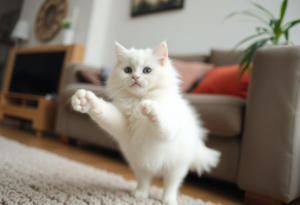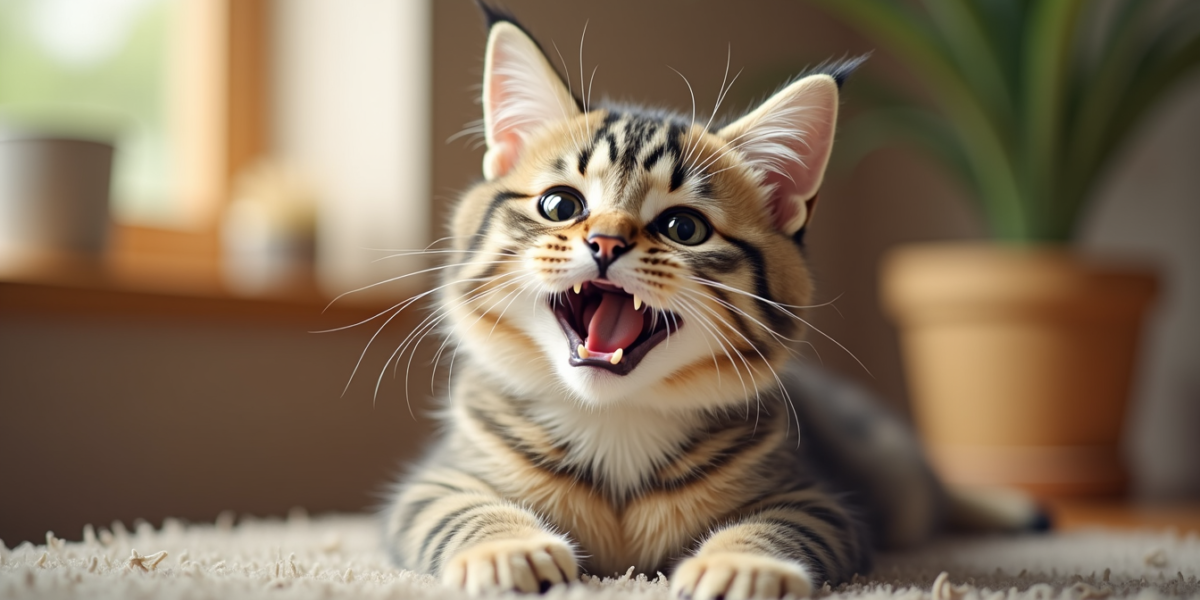The gentle, rhythmic sound of a cat’s purr is often considered one of the most soothing experiences in the presence of our feline friends. But have you ever paused to wonder what lies beneath this captivating phenomenon? Purring is more than just a sign of a happy cat; it’s a complex behavior steeped in science that reveals much about feline physiology, communication, and emotional well-being. From the vibrations that resonate within their bodies to the intricate neurological mechanisms that trigger this delightful sound, the science of purring encapsulates a world of mystery and intrigue. In this blog post, we will delve deep into the reasons behind your cat’s purring, exploring its evolutionary significance, the healing properties it may possess, and what it truly signifies about your kitty’s mood and health. Join us on this enlightening journey as we unravel the mystery behind your cat’s contentment, and discover how this simple sound is a window into the heart and soul of our beloved companions.

1. The Anatomy of a Purr: How Cats Produce This Unique Sound
The soothing sound of a cat’s purr is one of the most cherished aspects of feline companionship, but have you ever wondered how this delightful noise is produced? The anatomy of a purr is as fascinating as it is complex, involving a symphony of bodily mechanisms working in harmony. At the heart of this phenomenon are the cat’s laryngeal (voice box) muscles. When a cat inhales and exhales, these muscles rapidly contract and relax, causing the vocal cords to separate briefly, which produces the characteristic sound.
Interestingly, the purring mechanism is not solely dependent on vocalization. It is also enhanced by the unique structure of a cat’s respiratory system. As air flows in and out, the sound resonates through the cat’s throat and chest, creating that rich, comforting rumble that we associate with contentment.
Additionally, purring occurs at a frequency between 25 and 150 Hertz, a range that has been scientifically linked to therapeutic effects. This frequency is not just pleasant to our ears; it may also promote tissue regeneration and healing, suggesting that cats instinctively purr as a form of self-soothing and recovery.
Understanding the anatomy of a purr not only unravels the mystery of this enchanting sound but also deepens our appreciation for the remarkable biology of our feline friends. So, the next time your cat curls up beside you and begins to purr, you can relish not just the comforting sound but also the intricate processes that make it possible.
2. Evolutionary Significance: Why Cats Purr
Purring is one of the most endearing and mystifying behaviors of our feline companions, and its evolutionary significance is deeply intertwined with their survival and social interactions. To understand why cats purr, we must delve into their history and the role this soothing sound plays in their lives.
From an evolutionary standpoint, purring likely developed as a mechanism for communication and bonding. Kittens begin to purr at just a few days old, a signal to their mother that they are safe and content. This early form of communication fosters a strong maternal bond, ensuring that the mother cat remains attentive to her vulnerable offspring. As these kittens grow, the ability to purr allows them to communicate not only with their mothers but also with humans and other cats, signaling comfort and non-aggression.
In the wild, purring serves practical purposes as well. It helps cats to remain calm in stressful situations, which can be vital during hunts or encounters with predators. The rhythmic vibrations of purring are thought to have a calming effect, not just for the cat itself but also for those around it. This is particularly relevant during moments of discomfort, such as when a cat is injured or unwell. By purring, a cat can convey a sense of tranquility to both itself and its companions, potentially warding off threats and fostering a sense of safety within its environment.
Moreover, the soothing sound of purring can act as a form of self-healing. Research suggests that the frequency of the vibrations produced during purring—typically between 25 and 150 Hertz—has therapeutic properties that can promote healing in bones and tissues. This fascinating aspect of purring highlights its dual role: not only is it a signal of contentment, but it may also serve as a natural mechanism for recovery.
Thus, the evolutionary significance of purring goes beyond mere expression of happiness. It is a complex behavior that enhances communication, fosters social bonds, provides comfort during distress, and even facilitates healing. Understanding the intricacies of purring allows us to appreciate the depth of our feline friends’ emotional lives and the evolutionary adaptations that have shaped their behaviors over millennia.
3. The Emotional Spectrum: What Purring Really Means
Purring is often regarded as the quintessential sound of feline contentment, but the truth is far more nuanced. Understanding the emotional spectrum behind a cat’s purr can deepen our connection with these enigmatic creatures. While many pet owners associate purring with happiness, it can also indicate a range of other feelings, each revealing a layer of a cat’s emotional state.
At its core, a gentle purr emanates from a place of comfort and relaxation. When your cat curls up in your lap and begins to purr, it’s a clear sign that they feel safe and secure in their environment. This soothing rumble is not just a signal of bliss; it’s also a form of communication. Cats often purr when they seek attention or companionship, inviting humans to share in their peaceful moment. It’s their way of saying, “I’m happy, and I want to be near you.”
However, purring can take on different meanings in other contexts. For instance, cats may purr when they are in pain or distress, as a self-soothing mechanism. This phenomenon highlights the complexity of their emotional landscape. If your usually playful feline suddenly begins to purr while hiding or showing signs of discomfort, it could be a cry for help masked in the gentle vibrations of their purr.
Additionally, mother cats purr while nursing their kittens, creating an environment of safety that reassures the newborns. This instinctual behavior underscores purring’s role in the bonding process between a mother and her young, showcasing its importance beyond mere contentment.
In conclusion, while a purring cat often exudes an aura of happiness, it’s essential to recognize the multifaceted nature of this sound. By paying attention to your cat’s body language and the context in which they purr, you can gain deeper insights into their emotional world, ensuring that you respond to their needs with empathy and care. Understanding the emotional spectrum of purring not only enriches the human-feline bond but also fosters a greater appreciation for the complexities of our beloved pets.

4. The Healing Properties of Purring: Benefits for Cats and Humans
The soothing sound of a cat’s purr has long been associated with contentment and relaxation, but recent studies suggest that this gentle vibration carries a wealth of healing properties for both felines and their human companions. When a cat purrs, it produces a frequency of 25 to 150 Hertz, a range known to promote healing and reduce pain. This unique vibration has been linked to various physiological benefits, including the stimulation of healing processes in bones and tissues, which can aid in recovery from injuries or surgery.
For cats, purring serves as a self-soothing mechanism. It can help alleviate stress, reduce anxiety, and even bring comfort when they are unwell or in pain. The act of purring releases endorphins, natural painkillers that promote feelings of well-being. This is why you might notice your feline friend curling up and purring when they are feeling under the weather; it’s their way of nurturing themselves.
But the benefits of purring extend beyond the feline species. For humans, the sound and sensation of a cat’s purr can have a calming effect, providing a sense of comfort and emotional support. Research suggests that spending time with purring cats can lower stress levels, reduce anxiety, and even lower blood pressure. The rhythmic sound promotes relaxation and can help create a tranquil environment in homes, making it easier for individuals to unwind after a long day.
Moreover, the therapeutic effects of purring have captured the attention of pet therapists and healthcare professionals, who incorporate cats into treatment plans for patients suffering from various ailments, including PTSD, depression, and chronic pain. The simple act of listening to or feeling a cat purr can elicit a sense of calm and connection, reminding us of the profound bond we share with our furry companions.
In essence, the science of purring reveals a remarkable symbiosis between cats and humans, illustrating how these enchanting creatures not only bring joy and companionship into our lives but also contribute to our overall well-being. So the next time you hear that delightful rumble emanating from your cat, take a moment to appreciate its healing properties—it’s not just a sign of contentment; it’s a gentle reminder of the deep and restorative connection we can share with our pets.
5. Recognizing Other Feline Sounds: Purring in Context
While purring is often associated with a cat’s contentment, it’s only one piece of a complex auditory puzzle that encompasses a range of feline sounds. Understanding these sounds in context can provide deeper insights into your cat’s emotional state and intentions. For instance, a cat may purr while being petted or cuddled, indicating trust and relaxation. However, it may also purr when it is feeling unwell or in pain, using the soothing vibration as a self-soothing mechanism. This duality can sometimes confuse even the most attentive cat owners.
In addition to purring, cats communicate through a variety of vocalizations, each with its own meaning. A soft meow or trill often signifies a desire for attention or affection, whereas a more urgent meow may indicate hunger or distress. Hissing or growling, on the other hand, expresses discomfort or a warning to potential threats. By paying attention to these different sounds and the situations in which they occur, you can better tune into your cat’s feelings and needs.
Moreover, the subtle variations in pitch and intensity can also convey different messages. For example, a high-pitched purr might suggest excitement, while a lower, more rumbling purr could signal deep relaxation or even a warning. Observing your cat’s body language alongside these sounds—such as ear position, tail movements, and overall demeanor—can give you further clues about what your furry friend is trying to communicate.
By recognizing the context in which your cat purrs and the other sounds it makes, you can build a stronger bond with your feline companion, ensuring they feel understood and cared for. The science of purring intertwines with a broader tapestry of feline vocalization, revealing a rich and nuanced language that speaks to the heart of your cat’s experience.

6. Understanding Your Cat’s Contentment Through Purring
In conclusion, the soothing sound of purring is more than just a charming quirk of our feline companions; it’s a profound expression of their emotions and well-being. Understanding the science behind purring illuminates its role as a multifaceted form of communication, not just signaling contentment but also offering insights into health and healing. As cat owners, recognizing the nuances of this gentle vibration can deepen our bond with our pets, allowing us to respond to their needs more intuitively.
Purring serves as a reminder that our cats are not only companions but also complex beings with their own unique ways of expressing happiness and comfort. By paying attention to the context and accompanying behaviors of purring—whether it’s accompanied by a gentle nuzzle or playful antics—we can better appreciate their moods and emotions. Ultimately, embracing the science of purring enriches our understanding of our cats, enabling us to create an environment that fosters their contentment and strengthens our connection. With this knowledge, we can celebrate each purr as a testament to their joy in our shared journey, reinforcing the beautiful bond we have with these enigmatic creatures.
As we wrap up our exploration of feline communication, we hope this guide has provided valuable insights into decoding your cat’s body language and understanding the reasons behind that soothing purr. Recognizing the intricacies of your cat’s behavior not only enhances your bond but also fosters a deeper appreciation for their unique personality. By observing their movements, expressions, and sounds, you can respond more effectively to their needs—creating a happier and more harmonious home for both you and your whiskered companion. So, the next time your cat curls up beside you and begins to purr, you’ll know just how to translate that sweet serenade into love and comfort. If you have any more questions or want to share your own experiences, feel free to engage with us at Blogger. Thank you for joining us on this journey to better understand our beloved feline friends!


